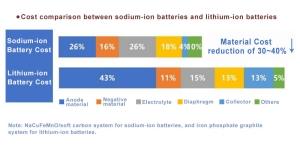A cost and resource analysis of sodium-ion batteries
Cost and Resource Analysis of Sodium-Ion Batteries: Economic Implications and Sustainability
As the demand for efficient and sustainable energy storage solutions grows, sodium-ion batteries are gaining significant attention. This article explores the economic and resource-based aspects of sodium-ion batteries, offering a comprehensive analysis of their cost-effectiveness and resource utilization, and detailing how Himax Electronics is enhancing these aspects through technological innovation.

Understanding the Economics of Sodium-Ion Batteries
-
Material Availability and Cost:
-
Abundant Resources: Sodium, unlike lithium, is highly abundant and widely available globally. It is one of the most common elements on earth, significantly reducing the geopolitical and economic risks associated with its supply.
-
Lower Material Costs: The cost of raw sodium is considerably lower than that of lithium. This cost-effectiveness stems from the ease of extraction and processing, as sodium can be derived from common salt (NaCl), which is both plentiful and inexpensive.
-
-
Manufacturing and Production Costs:
-
Existing Infrastructure: Sodium-ion batteries can leverage existing manufacturing infrastructures initially designed for lithium-ion batteries. This adaptability reduces the need for new investments in specialized equipment and facilities, further lowering entry barriers for battery production.
-
Scalability: The scalability of sodium-ion battery production promises substantial economies of scale. As production ramps up, the per-unit cost of batteries is expected to decrease, making them an even more attractive option for large-scale energy storage and electric vehicles.
-
Resource Efficiency and Sustainability
-
Environmental Impact:
-
Reduced Mining Impact: The extraction of sodium does not require intensive mining operations, which are often associated with significant environmental degradation. Instead, sodium can be obtained from seawater and mineral deposits with minimal ecological disruption.
-
Recycling Potential: Sodium-ion batteries offer promising recycling prospects. Their simpler chemical makeup makes them easier to recycle than lithium-ion batteries, which require more complex and costly recycling processes.
-
-
Lifecycle and Durability:
-
Long Service Life: Innovations in cathode materials and electrolyte formulations are improving the life expectancy of sodium-ion batteries, which is critical for applications where frequent battery replacement is logistically challenging or economically unfeasible.
-
Maintenance Requirements: Sodium-ion batteries generally have lower maintenance requirements compared to lead-acid and some lithium-ion batteries, reducing the total cost of ownership over their operational lifespan.
-
Himax Electronics: Driving Cost Efficiency and Resource Optimization
Himax Electronics is actively involved in enhancing the performance and cost-efficiency of sodium-ion batteries through advanced technology and innovative solutions.
-
Battery Management Systems (BMS):
-
Optimal Charging and Discharging: Himax’s state-of-the-art BMS technology ensures optimal charging and discharging of sodium-ion batteries, which enhances their efficiency and prolongs their lifespan. This technology helps prevent overcharging and deep discharging, both of which can significantly affect battery health.
-
Energy Efficiency Maximization: By improving the overall energy management of sodium-ion batteries, Himax contributes to their economic viability, ensuring they deliver maximum value for their cost.
-
-
Sustainable Technology Development:
-
Innovation in Battery Technology: Himax is at the forefront of developing new technologies that increase the energy density and reduce the charge time of sodium-ion batteries, pushing forward the boundaries of what these batteries can achieve.
-
Commitment to Sustainability: Himax’s dedication to environmental sustainability influences its approach to battery development, focusing on technologies that reduce environmental impact and enhance the recyclability of battery materials.
-
Conclusion
Sodium-ion batteries(SODIUM BATTERY) represent a promising alternative to traditional battery technologies, with significant advantages in terms of cost, resource availability, and environmental impact. As these batteries continue to evolve, their role in sustainable energy storage is expected to expand. Himax Electronics is committed to advancing sodium-ion battery technology, making it more efficient, cost-effective, and sustainable. For those looking to understand the full potential of sodium-ion batteries or to explore innovative battery solutions, Himax offers expertise and products that set industry standards.




